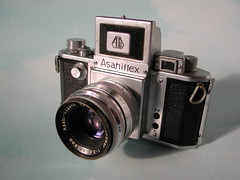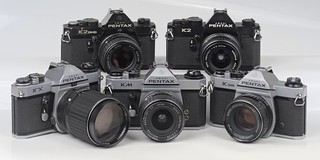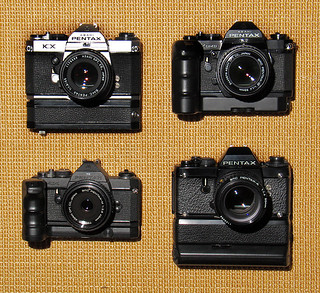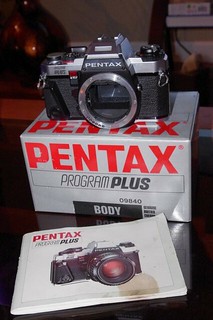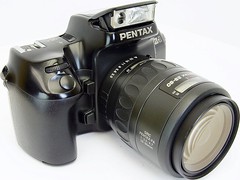Difference between revisions of "Pentax"
Hanskerensky (talk | contribs) m (→Technical information: Repaired Link URL) |
Nparsons13 (talk | contribs) (Minor edits/corrections) |
||
| (45 intermediate revisions by 5 users not shown) | |||
| Line 1: | Line 1: | ||
| + | '''Pentax''' is a Japanese lens and camera maker founded in 1919 under the name Asahi Optical Company. In 2002 it changed its name to Pentax Corporation. It is currently (2023) owned by [[Ricoh Imaging]] Corp. | ||
| + | |||
{{Flickr image | {{Flickr image | ||
| image_source=http://www.flickr.com/photos/wolf-t/5233851707/in/pool-camerawiki | | image_source=http://www.flickr.com/photos/wolf-t/5233851707/in/pool-camerawiki | ||
| Line 7: | Line 9: | ||
|image_rights= nc | |image_rights= nc | ||
}} | }} | ||
| − | + | ||
__TOC__ | __TOC__ | ||
== History == | == History == | ||
| − | The company that would become '''Pentax''' was founded in 1919 as '''Asahi Kogaku Kogyo G.K.''' ( | + | The company that would become '''Pentax''' was founded in 1919 as '''Asahi Kogaku Kogyo G.K.''' (旭光学工業株式会社) . It was originally an optical company, beginning by making glasses under the Aoco brand (presumably the acronym of <u>A</u>sahi <u>O</u>ptical <u>Co</u>mpany), and made its first Aoco projection lens in 1923.<REF> Yazawa, p.12 of {{CCN}} no.247. </REF> It began to produce camera lenses in the early 1930s under the leadership of CEO '''Kajiwara Kumao ''' and his closest collaborator, Matsumoto Saburo.<REF> Yazawa, p.12 of {{CCN}} no.247. </REF> These lenses were not marked as made by Asahi and were produced for various camera models made by other makers. From 1933 the company produced [[Zion and Optor|Optor]] and meniscus achromat lenses designed at [[Konica|Rokuoh-sha]] for [[Konica|Konishiroku]] models. From the mid-1930s to the end of World War II the company was also the main supplier of Molta, then Chiyoda Kogaku Seiko (predecessors of [[Minolta]]), whose cameras were equipped with Coronar and Promar lenses.<REF> The Coronar and Promar lenses are attributed to Asahi in various sources, and this attribution is confirmed by the {{Inquiry1943_short}}, lens items Lb5, Lb39, Lc9, and N2. </REF><ref>[https://www.aohc.it/testi.php?id_testi=50 A brief history of the Asahi Optical Corporation by Derek J. White ARPS] Spotmatic Magazine 32 -2002 - at the Asahi Optical Historical Club. </ref> |
| − | The company changed status in 1938, becoming '''Asahi Kogaku Kogyo K.K.''' | + | The company changed status in 1938, becoming '''Asahi Kogaku Kogyo K.K.''' or '''Asahi Optical Co.''' based in Tokyo.<REF> Its address in 1943 was Tokyo-to Itabashi-ku Itabashi-cho. Source: {{Inquiry1943_short}}. </REF> |
After the war, Asahi made binoculars and polished lenses for several other companies. | After the war, Asahi made binoculars and polished lenses for several other companies. | ||
| − | The first camera produced by Asahi was the [[Asahiflex]], | + | The first camera produced by Asahi, made as a prototype in 1951 and released in 1952, was the [[Asahiflex]], which was also the first Japanese 35mm [[SLR]]. One of the models of the Asahiflex series, the Asahiflex IIb, was the first [[35mm]] SLR to have an [[instant-return mirror]], thus solving the problem of [[viewfinder blackout|mirror blackout]] that had plagued SLRs up to that time (early SLRs left the mirror in its "up" position until the camera was wound for the next shot, blacking out the viewfinder). |
| − | A series of lenses bearing the name [[Takumar]] in honor of '''Kajiwara Takuma''' , brother of the founder, were developed for the Asahiflex, | + | A series of lenses bearing the name ''[[Takumar]]'' in honor of '''Kajiwara Takuma''', brother of the founder, were developed for the Asahiflex, which used the 37mm screw mount (1952). The name Takumar was carried over to the 35mm [[42mm screw mount lenses|M42x1 mount]] and 6x7 cameras and went through a series of iterations as build quality and coatings were developed with names such as Super-Takumar, Super-Multi-Coated Takumar, and SMC Takumar until 1975, when the name was changed to SMC-Pentax (even though Takumar lenses were in the catalog until 1979). |
{{Flickr_image | {{Flickr_image | ||
| Line 29: | Line 31: | ||
}} | }} | ||
| − | '''Pentax''' was originally the name of another 35mm [[SLR]] camera model, introduced in 1957 and successor of the Asahiflex. The name is derived from the shape of the prism used in SLR cameras ([[pentaprism|''penta''prism]]), and the ending deliberately looks like the [[Zeiss Ikon]] [[Contax rangefinder|Con'''tax''']]. In fact, the name Pentax was a property of [[Zeiss Ikon]] (West) until they sold it to Asahi Optical Co., maybe strategically because | + | '''Pentax''' was originally the name of another 35mm [[SLR]] camera model, introduced in 1957 and successor of the Asahiflex. The name is derived from the shape of the prism used in SLR cameras ([[pentaprism|''penta''prism]]), and the ending syllable deliberately looks like that of the [[Zeiss Ikon]] [[Contax rangefinder|Con'''tax''']]. In fact, the name Pentax was a property of [[Zeiss Ikon]] (West) until they sold it to Asahi Optical Co., maybe strategically, because Zess Ikon's East-German concurrent had relabeled its [[Contax S]] SLRs to [[Pentacon]]. |
| − | |||
| − | |||
| − | |||
| − | + | Early Pentax cameras were sold in the USA stamped with the name Tower, the house brand of [[Sears]] Roebuck & Co., and many others carry the name Heiland, which was the importer and distributor in the USA. Heiland was later acquired by Honeywell until the partnership ended in 1976. These cameras were exactly the same as the ones stamped with the Asahi name. | |
| + | Pentax was at the time one of the big Japanese camera manufacturers, given their success with 35mm[[SLR]] cameras such as the Asahiflex, the Pentax, and the Spotmatic lines. In 1969 Pentax introduced a complete [[system camera|camera systems]] for [[rollfilm]], the [[Pentax 6x7]]. Later it introduced its tiny and popular [[Pentax Auto 110]] for type [[110 film]] cassettes. | ||
| − | + | In 1957 [[Pentax|Asahi Optical Co]] adopted the M42x1 lens mount for the successful [[Pentax_(original)|Asahi Pentax (AP) camera]], which introduced the auto-diaphragm in the '''Auto-Takumar''' lenses for the K-camera and continued using it in the successful S/H line and in the [[Spotmatic]]. By 1975 Pentax tried to take the lead with a new lens bayonet, which overcame the limitations of the screw mount and maintained the same flange/film distance as that of the [[M42]] screw mount, thus making it easier for lens makers to offer lenses for both mounts. In fact, the K mount should have been an open bayonet standard, and a handful of other renowned camera makers also used it, among them [[:Category:K mount|Pentax's K-mount]]: [[Zenit]], [[Topcon]], [[Chinon]], [[Cosina]],[[Ricoh]], and [[Samsung]]. But most importantly, the mount was further developed and is still in use for Pentax's [[DSLR|digital SLRs]] and even for one of its [[CSC]]s, making all new cameras back-compatible. | |
| − | |||
{{Flickr_image | {{Flickr_image | ||
|image_source= http://www.flickr.com/photos/vagn49/8253747238/in/pool-camerawiki | |image_source= http://www.flickr.com/photos/vagn49/8253747238/in/pool-camerawiki | ||
| − | |image= http://farm9.staticflickr.com/8488/ | + | |image= http://farm9.staticflickr.com/8488/8253747238_d458cae34f_m.jpg |
|image_align= left | |image_align= left | ||
|image_text= Auto 110 <br>Pentax' smallest [[SLR]] | |image_text= Auto 110 <br>Pentax' smallest [[SLR]] | ||
| Line 48: | Line 47: | ||
|image_rights= wp | |image_rights= wp | ||
}} | }} | ||
| + | The company kept the name '''Asahi Optical Co.''' until it became '''Pentax Corporation''' in 2002. | ||
| + | After successful prototyping since 2000 the company launched [[Pentax *ist D|its first DSLR]] with a film twin in 2003, with [[:Category:K mount|Pentax K mount]]. A merger with the [[Hoya|Hoya Corporation]] was completed on October 1, 2007. The new name became '''Hoya Pentax HD Corporation''' (HOYA-HD{{kabu}}).<REF> [https://web.archive.org/web/20070106203216/http://www.hoya.co.jp/data/current/newsobj-365-pdf.pdf Japanese version of the news release (archived)] found in the Hoya official website. The name "HOYA PENTAX HD Corporation" is written in capital letters. </REF> In summer 2011 [[Hoya]] announced that it was selling the imaging branch of Pentax to [[Ricoh]]<REF>[https://web.archive.org/web/20170310175440/https://www.engadget.com/2011/07/01/ricoh-set-to-acquire-pentax-camera-brand-and-business-get-serio/ Summer 2011: Hoya confirms sale rumours. (archived)]</REF> while it will keep the medical branch of Pentax for itself. | ||
| − | In July | + | |
| + | In July 2011 [[Ricoh]] announced its intentions to purchase the Pentax photographic equipment business from Hoya (which, however, would retain some Pentax-branded medical product lines, etc.)<REF>[https://web.archive.org/web/20110718055246/http://www.hoya.co.jp/english/news/latest/d0h4dj0000001fv8-att/d0h4dj0000001fwi.pdf Hoya press release (archived)] (PDF) on sale of Pentax assets to Ricoh</REF>. In August of 2013 the name of the company was changed to [[Ricoh Imaging]]. It was announced that the Ricoh branding would be used on compact cameras, while Pentax-branded products would be the DSLRs, interchangeable-lens compact cameras, and binoculars. | ||
{{br}} | {{br}} | ||
== Digital == | == Digital == | ||
=== SLR === | === SLR === | ||
| + | {|class=floatright | ||
| + | | | ||
| + | {{Flickr image | ||
| + | | image_source=https://www.flickr.com/photos/95742794@N05/32599102611/in/pool-camerawiki | ||
| + | | image=https://live.staticflickr.com/303/32599102611_01270bfdf5_m.jpg | ||
| + | | image_align=right | ||
| + | | image_text=*ist | ||
| + | |image_by= Jörg Krüger | ||
| + | |image_rights= with permission | ||
| + | }} | ||
| + | | | ||
| + | {{Flickr image | ||
| + | | image_source=https://www.flickr.com/photos/ossy59/3244093363/in/pool-camerawiki | ||
| + | | image=https://live.staticflickr.com/3304/3244093363_1f3ece8736_m.jpg | ||
| + | | image_align=right | ||
| + | | image_text=*istD black | ||
| + | |image_by= Jürgen Oswald | ||
| + | |image_rights= with permission | ||
| + | }} | ||
| + | |- | ||
| + | | | ||
| + | {{Flickr image | ||
| + | | image_source=https://www.flickr.com/photos/nubobo/5214209927/in/pool-camerawiki | ||
| + | | image=https://live.staticflickr.com/5249/5214209927_6b1f57a4e9_m.jpg | ||
| + | | image_align=right | ||
| + | | image_text=K7 | ||
| + | |image_by= nubobo | ||
| + | |image_rights= with permission | ||
| + | }} | ||
| + | | | ||
| + | {{Flickr image | ||
| + | | image_source=https://www.flickr.com/photos/95742794@N05/32099354835/in/pool-camerawiki | ||
| + | | image=https://live.staticflickr.com/374/32099354835_07e98ca9b5_m.jpg | ||
| + | | image_align=right | ||
| + | | image_text=K-1 <br> full frame | ||
| + | |image_by= Jörg Krüger | ||
| + | |image_rights= with permission | ||
| + | }} | ||
| + | |- | ||
| + | | | ||
| + | {{Flickr_image | ||
| + | |image_source= https://www.flickr.com/photos/maoby/42958786850/in/pool-camerawiki/ | ||
| + | |image= https://live.staticflickr.com/1858/42958786850_0c245abbf0_m.jpg | ||
| + | |image_align= left | ||
| + | |image_text= Pentax K-01 <br> Mirrorless K-mount | ||
| + | |image_by= maoby | ||
| + | |image_rights= wp | ||
| + | }} | ||
| + | | | ||
| + | {{Flickr_image | ||
| + | |image_source=https://www.flickr.com/photos/195784286@N05/52579892443/in/pool-camerawiki/ | ||
| + | |image=https://live.staticflickr.com/65535/52579892443_4df0371a59_m.jpg | ||
| + | |image_align= left | ||
| + | |image_text= Pentax K-P | ||
| + | |image_by= Pawel Swiatek | ||
| + | |image_rights= wp | ||
| + | }} | ||
| + | |} | ||
* Pentax MZ-D (2000) prototype, never released | * Pentax MZ-D (2000) prototype, never released | ||
* [[Pentax *ist D]] (2003) | * [[Pentax *ist D]] (2003) | ||
| Line 64: | Line 124: | ||
* [[Pentax K10D]] (2006) also sold by [[Samsung]] as [[Samsung GX-10]] | * [[Pentax K10D]] (2006) also sold by [[Samsung]] as [[Samsung GX-10]] | ||
* Pentax AP 50th Anniv (2007) concept, never released <ref>[http://dc.watch.impress.co.jp/cda/other/2007/06/01/6368.html Pentax Classic DSLR concept] at [http://watch.impress.co.jp/ Watch Impress]</ref> | * Pentax AP 50th Anniv (2007) concept, never released <ref>[http://dc.watch.impress.co.jp/cda/other/2007/06/01/6368.html Pentax Classic DSLR concept] at [http://watch.impress.co.jp/ Watch Impress]</ref> | ||
| − | |||
| − | |||
| − | |||
| − | |||
| − | |||
| − | |||
| − | |||
| − | |||
* [[Pentax K100D|Pentax K100D Super]] (2007) | * [[Pentax K100D|Pentax K100D Super]] (2007) | ||
* [[Pentax K20D]] (2008) also sold by [[Samsung]] as Samsung GX-20 | * [[Pentax K20D]] (2008) also sold by [[Samsung]] as Samsung GX-20 | ||
| Line 89: | Line 141: | ||
* [[Pentax K-70]] (2016) | * [[Pentax K-70]] (2016) | ||
* [[Pentax K-1]] (2016) - Full frame | * [[Pentax K-1]] (2016) - Full frame | ||
| − | * [[Pentax K-P]] (2017) | + | * [[Pentax KP|Pentax K-P]] (2017) |
* [[Pentax K-3II]] (2017) | * [[Pentax K-3II]] (2017) | ||
| − | * [[Pentax K- | + | * [[Pentax K-1|Pentax K-1 II]] (2018) - Full frame |
* [[Pentax K-3III]] (2021) | * [[Pentax K-3III]] (2021) | ||
| + | * Pentax K-F (2022) | ||
| + | * [[Pentax K-3III | Pentax K3-III Monochrome]] (2023) | ||
| + | {{br}} | ||
=== Medium Format SLR === | === Medium Format SLR === | ||
| Line 102: | Line 157: | ||
* [[Pentax Q]] (2011) | * [[Pentax Q]] (2011) | ||
| + | ===Interchangeable-lens mirrorless=== | ||
| + | |||
| + | * [[Pentax K-01]] (2012) with K-mount | ||
| + | |||
| + | {{br}} | ||
=== Point and Shoot Cameras === | === Point and Shoot Cameras === | ||
| Line 222: | Line 282: | ||
* Pentax RS1500 | * Pentax RS1500 | ||
|} | |} | ||
| + | {{br}} | ||
== 35mm film == | == 35mm film == | ||
| Line 248: | Line 309: | ||
The family of cameras included: | The family of cameras included: | ||
* Spot-Matic prototype (1960) | * Spot-Matic prototype (1960) | ||
| − | * [[Pentax Spotmatic]] | + | * [[Pentax Spotmatic]] (1964) |
| − | * [[Pentax Spotmatic|Pentax SL]] (1968) | + | * [[Pentax Spotmatic|Pentax SL]] (1968) meterless version of the Spotmatic |
* [[Pentax Spotmatic|Pentax Spotmatic II]] (1971) and [[Pentax_Spotmatic#The_Spotmatic_SP_II|IIa]] for the American market | * [[Pentax Spotmatic|Pentax Spotmatic II]] (1971) and [[Pentax_Spotmatic#The_Spotmatic_SP_II|IIa]] for the American market | ||
| − | * [[Pentax Spotmatic|Pentax Spotmatic F]] (1973) In combination with '''S-M-C Takumar''' lenses, allowed for fully | + | * [[Pentax Spotmatic|Pentax Spotmatic F]] (1973) In combination with '''S-M-C Takumar''' lenses, allowed for fully open metering |
With the advent of electronics, Asahi developed a camera that used that new technology; the '''Electro-Spotmatic''' had "electronic shutter" that was fully automatic and without steps. | With the advent of electronics, Asahi developed a camera that used that new technology; the '''Electro-Spotmatic''' had "electronic shutter" that was fully automatic and without steps. | ||
| Line 258: | Line 319: | ||
* [[Pentax ES II]] (1973) | * [[Pentax ES II]] (1973) | ||
| − | Asahi also had budget models for entry level enthusiats | + | Asahi also had budget models for entry level enthusiats: |
* [[Pentax Spotmatic|Pentax SP500]] (1971) | * [[Pentax Spotmatic|Pentax SP500]] (1971) | ||
* [[Pentax Spotmatic|Pentax SP1000]] (1974) | * [[Pentax Spotmatic|Pentax SP1000]] (1974) | ||
| Line 266: | Line 327: | ||
=== K-mount manual focus SLR === | === K-mount manual focus SLR === | ||
====Pentax K series==== | ====Pentax K series==== | ||
| − | These cameras were launched in 1975, following the success of the Spotmatic by replacing the M42 mount with K-mount while maintaining the same flange to film distance. | + | {|class=floatright |
| + | |{{Flickr_image | ||
| + | |image_source= https://www.flickr.com/photos/95742794@N05/52576187054/in/pool-camerawiki/ | ||
| + | |image= https://live.staticflickr.com/65535/52576187054_32beef5e65_n.jpg | ||
| + | |image_align= right | ||
| + | |image_text= Pentax K models | ||
| + | |image_by= Jörg Krüger | ||
| + | |image_rights= with permission | ||
| + | }} | ||
| + | These cameras were launched in 1975, following the success of the Spotmatic, by replacing the M42 mount with K-mount while maintaining the same flange to film distance. Despite being the one with less features of this series, and due to its simplicity and robustness, the [[Pentax K1000|K1000]] became the eternal ''student camera.'' | ||
* [[Pentax K2]] | * [[Pentax K2]] | ||
* [[Pentax K2DMD]] | * [[Pentax K2DMD]] | ||
| Line 272: | Line 342: | ||
* [[Pentax KM]] | * [[Pentax KM]] | ||
* [[Pentax K1000]] | * [[Pentax K1000]] | ||
| + | {{br}} | ||
====Pentax M series==== | ====Pentax M series==== | ||
| − | + | ||
| − | + | {|class=floatright | |
| − | + | |{{Flickr_image | |
| − | + | |image_source= http://www.flickr.com/photos/camerawiki/47030002244/in/pool-camerawiki | |
| − | + | |image= https://live.staticflickr.com/65535/47030002244_962348867b_n.jpg | |
| − | + | |image_align= right | |
| − | + | |image_text= Pentax MV-1 <br> by Brian Godbold | |
| − | + | |image_by= camerawiki | |
| − | + | |image_rights= with permission | |
| − | + | }} | |
| − | + | |- | |
| − | {{Flickr_image | + | |{{Flickr_image |
|image_source= https://www.flickr.com/photos/wolf-t/4944929144/in/pool-camerawiki/ | |image_source= https://www.flickr.com/photos/wolf-t/4944929144/in/pool-camerawiki/ | ||
|image= https://live.staticflickr.com/4097/4944929144_26635a9a79_n.jpg | |image= https://live.staticflickr.com/4097/4944929144_26635a9a79_n.jpg | ||
| Line 293: | Line 364: | ||
|image_rights= with permission | |image_rights= with permission | ||
}} | }} | ||
| + | |} | ||
| + | Innovation in the form of miniaturization and cameras that were more compact, lighter, and reliable was introduced as the M line in 1976. | ||
| + | This generation also brought the line of '''SMC-Pentax-M''' lenses. | ||
| + | Aperture priority and the use of buttons instead of dials was a characteristic, together with very bright viewfinders with split image. | ||
| + | '''Autofocus''' was introduced for the first time in a Pentax camera with the ME-F, which used a special lens with built-in focusing motor. | ||
| + | |||
| + | * [[Pentax MX]] (1976) | ||
| + | * [[Pentax ME]] (1976) | ||
| + | * [[Pentax ME Super]] (1979) | ||
| + | * [[Pentax ME-F]] The 1st AutoFocus camera from Pentax (1981) | ||
| + | * [[Pentax MV]] (1979) | ||
| + | * [[Pentax MV1]] (1980) | ||
| + | * [[Pentax MG]] (1981) | ||
| + | * Pentax MF | ||
| + | * [[Pentax MF-1]], scientific use | ||
| + | {{br}} | ||
| + | |||
====Pentax A series:==== | ====Pentax A series:==== | ||
| − | These cameras introduced electronic communication between the lens and the camera to allow for automatic exposure ( | + | These cameras introduced electronic communication between the lens and the camera to allow for automatic exposure (Program mode). K-mount lenses with electronic contacts (SMC Pentax-A) were introduced to complement these cameras. |
| − | * [[Pentax Super A]], Super Program (USA) | + | |
| − | * [[Pentax Program A]], Program Plus (USA) | + | * [[Pentax Super A]], Super Program (USA) (1984) |
| − | * [[Pentax A3]], A3000 (USA) | + | * [[Pentax Program A]], Program Plus (USA) (1984) |
| + | * [[Pentax A3]], A3000 (USA) (1984) | ||
| + | |||
| + | {| class="wikitable" | ||
| + | | | ||
| + | {{Flickr_image | ||
| + | |image_source=https://www.flickr.com/photos/95742794@N05/40941941130/in/pool-camerawiki | ||
| + | |image=https://live.staticflickr.com/1757/40941941130_76e75591b0_n.jpg | ||
| + | |image_align= Center | ||
| + | |image_text= Pentax Super A | ||
| + | |image_by= Jörg Krüger | ||
| + | |image_rights= wp | ||
| + | }} | ||
| + | | | ||
| + | {{Flickr_image | ||
| + | |image_source=https://www.flickr.com/photos/titrisol/9030664752/in/pool-camerawiki | ||
| + | |image=https://live.staticflickr.com/2871/9030664752_509dbc7fee_n.jpg | ||
| + | |image_align= Center | ||
| + | |image_text= Pentax ProgramPlus | ||
| + | |image_by= Pablo Coronel | ||
| + | |image_rights= wp | ||
| + | }} | ||
| + | |- | ||
| + | | | ||
| + | {{Flickr_image | ||
| + | |image_source=https://www.flickr.com/photos/alf_sigaro/40473905843/in/pool-camerawiki | ||
| + | |image=https://live.staticflickr.com/7849/40473905843_11c544ddd0_n.jpg | ||
| + | |image_align= Center | ||
| + | |image_text= Pentax P30T | ||
| + | |image_by= Alf Sigaro | ||
| + | |image_rights= wp | ||
| + | }} | ||
| + | | | ||
| + | {{Flickr_image | ||
| + | |image_source=https://www.flickr.com/photos/95742794@N05/51932284002/in/pool-camerawiki/ | ||
| + | |image=https://live.staticflickr.com/65535/51932284002_327cb6f682_n.jpg | ||
| + | |image_align= Center | ||
| + | |image_text= Pentax A3 | ||
| + | |image_by= Jörg Krüger | ||
| + | |image_rights= wp | ||
| + | }} | ||
| + | |} | ||
====Pentax P series:==== | ====Pentax P series:==== | ||
| − | * [[Pentax P30/P3]] | + | * [[Pentax P30/P3]] (1985) |
| − | * [[Pentax P30n/P3n/P30t]] | + | * [[Pentax P30n/P3n/P30t]] (1988) |
| − | * [[Pentax P50/P5]] | + | * [[Pentax P50/P5]] (1985) |
===Pentax LX=== | ===Pentax LX=== | ||
| − | * [[Pentax LX]] (1980) Professional grade camera LX refers to the 60th Anniversary of Asahi Optical | + | * [[Pentax LX]] (1980) Professional grade camera. LX refers to the 60th Anniversary of Asahi Optical Company. |
| − | ** Pentax LX 2000 - | + | ** Pentax LX 2000 - special edition for the year 2000 |
| + | {{br}} | ||
=== K-mount autofocus SLR === | === K-mount autofocus SLR === | ||
{|class=floatright | {|class=floatright | ||
| − | |||
| − | |||
| − | |||
| − | |||
| − | |||
| − | |||
| − | |||
| − | |||
| − | |||
| − | |||
| | | | ||
{{Flickr image | {{Flickr image | ||
| image_source=http://www.flickr.com/photos/arcticcorsair/2214405647/in/pool-camerawiki | | image_source=http://www.flickr.com/photos/arcticcorsair/2214405647/in/pool-camerawiki | ||
| − | | image=http://farm3.static.flickr.com/2319/ | + | | image=http://farm3.static.flickr.com/2319/2214405647_ec6a0d251a_m.jpg |
| image_align=right | | image_align=right | ||
| image_text=Z-1 | | image_text=Z-1 | ||
| Line 332: | Line 452: | ||
| | | | ||
{{Flickr image | {{Flickr image | ||
| − | | image_source= | + | | image_source=https://www.flickr.com/photos/binocameracollection/45976722565/in/pool-camerawiki |
| − | | image= | + | | image=https://live.staticflickr.com/7921/45976722565_02a1fe9495_m.jpg |
| image_align=right | | image_align=right | ||
| − | | image_text=MZ-S | + | | image_text=Pentax MZ-S <br> |
| − | |image_by= | + | With Battery grip BG-10 |
| − | |image_rights= | + | |image_by= Antonio Rodríguez |
| + | |image_rights=wp | ||
| + | }} | ||
| + | |- | ||
| + | | | ||
| + | {{Flickr_image | ||
| + | |image_source= https://www.flickr.com/photos/gfs_photo/29705064680/in/pool-camerawiki/ | ||
| + | |image=https://live.staticflickr.com/7696/29705064680_a57ceed0e2_m.jpg | ||
| + | |image_align= center | ||
| + | |image_text= Pentax MZ-M <br> manual focus | ||
| + | |image_by= teknoec | ||
| + | |image_rights= wp | ||
}} | }} | ||
|} | |} | ||
| Line 355: | Line 486: | ||
====MZ/ZX series==== | ====MZ/ZX series==== | ||
| − | A series of cameras that were popular in the late | + | A series of cameras that were popular in the late 1990s, the single-digit cameras were aimed at advanced amateurs, while the double digits were aimed to amateurs. All had plastic bodies and several program modes. |
| − | The cameras used the MZ designation in the European and Asian markets | + | The cameras used the MZ designation in the European and Asian markets and ZX in the Americas. |
* [[Pentax MZ-5/ZX-5]] (1996) | * [[Pentax MZ-5/ZX-5]] (1996) | ||
* [[Pentax MZ-3]]/ZX-3 (1997) | * [[Pentax MZ-3]]/ZX-3 (1997) | ||
| Line 368: | Line 499: | ||
* Pentax MZ-60/ZX-60 (2002) | * Pentax MZ-60/ZX-60 (2002) | ||
* [[Pentax *ist]] (2003) - Launched at the same time in film and digital | * [[Pentax *ist]] (2003) - Launched at the same time in film and digital | ||
| − | * [[Pentax MZ-M/ZX-M]] (1997) - The oddball in | + | * [[Pentax MZ-M/ZX-M]] (1997) - The oddball in these generation, a consumer camera that had all manual controls. |
| + | {{br}} | ||
=== Compact === | === Compact === | ||
| Line 376: | Line 508: | ||
* [[Pentax Pino]] series (e.g. Pino 35M) | * [[Pentax Pino]] series (e.g. Pino 35M) | ||
* [[Pentax Sport]] (DX) | * [[Pentax Sport]] (DX) | ||
| − | + | {{br}} | |
== 645 Medium Format == | == 645 Medium Format == | ||
''1969-2010''<br> | ''1969-2010''<br> | ||
| Line 390: | Line 522: | ||
* [[Pentax 67]] | * [[Pentax 67]] | ||
* [[Pentax 67|Pentax 67 II]] | * [[Pentax 67|Pentax 67 II]] | ||
| − | + | {{br}} | |
== 110 film == | == 110 film == | ||
<div class="plainlinks floatright">[http://www.flickr.com/photos/martintaylor/22827035/in/pool-camerawiki http://static.flickr.com/18/22827035_780ebea7e1_t.jpg]<br><small> Image by {{image author|Martin Taylor}} </small><br>{{non-commercial}}</div> | <div class="plainlinks floatright">[http://www.flickr.com/photos/martintaylor/22827035/in/pool-camerawiki http://static.flickr.com/18/22827035_780ebea7e1_t.jpg]<br><small> Image by {{image author|Martin Taylor}} </small><br>{{non-commercial}}</div> | ||
| Line 402: | Line 534: | ||
* [[Pentax efina T]] | * [[Pentax efina T]] | ||
| + | {{br}} | ||
==Lenses== | ==Lenses== | ||
| − | Asahi Optical began as a lens fabricator | + | Asahi Optical began as a lens fabricator. After World War II they also entered the camera business, and with the introduction of the '''Asahiflex''' they also introduced their own line of lenses, giving them the name '''[[Takumar]]'''. Takumar lenses were used in 35mm and the Pentax 6x7 until 1975, when the badge was replaced with '''smc-Pentax'''. Takumar lenses became legendary in the 1960s, with millions produced, and many are still used today on digital cameras. |
<br> | <br> | ||
===Asahiflex (37mm) Mount=== | ===Asahiflex (37mm) Mount=== | ||
*Standard lenses: | *Standard lenses: | ||
| − | ** Takumar 50mm f/3.5 ( | + | ** Takumar 50mm f/3.5 (three different versions) |
** Takumar 58mm f/2.4 | ** Takumar 58mm f/2.4 | ||
*Telephotos: | *Telephotos: | ||
| Line 420: | Line 553: | ||
* type 0 (1957): Takumar-preset: Replaced the older 37mm version of the Takumar line for the original AP cameras | * type 0 (1957): Takumar-preset: Replaced the older 37mm version of the Takumar line for the original AP cameras | ||
* type I (1959): Auto-Takumar: A lever is added to allow for full aperture focusing before shooting, for the Pentax K camera | * type I (1959): Auto-Takumar: A lever is added to allow for full aperture focusing before shooting, for the Pentax K camera | ||
| − | * type II (1962): Super-Takumar: Fully-automatic diaphragm that does not needs to be cocked manually, | + | * type II (1962): Super-Takumar: Fully-automatic diaphragm that does not needs to be cocked manually, with an Auto/Manual switch on the lens. Single layer of coating; however, some later versions are multicoated as Asahi's coating technology improved. These lenses were made popular with the success of the [[Spotmatic]] cameras. The famous 50mm f/1.4 was introduced at that time. |
| − | * type III (1971): Super-Multi-Coated Takumar: A | + | * type III (1971): Super-Multi-Coated Takumar: A seven-layer coating was applied for these lenses, the best available at the time, with improvements in contrast and color rendition. A mechanism for open-aperture metering with the Spotmatic-F/ES/ES-II was added to the lens. |
| − | * type IV: SMC Takumar (1974): Identical optically to type III but uses a rubberized instead of the metal focusing ring | + | * type IV: SMC Takumar (1974): Identical optically to type III but uses a rubberized instead of the metal focusing ring and a different diaphragm ring as a prelude to the change of mount to K bayonet. |
{| style="border-spacing:0";style="vertical-align: top;" | {| style="border-spacing:0";style="vertical-align: top;" | ||
| Line 576: | Line 709: | ||
====Official websites==== | ====Official websites==== | ||
* [https://web.archive.org/web/20120204090553/http://www.pentaximaging.com/ Pentax Imaging Company] Official website (including the [https://web.archive.org/web/20130617030934/http://www.pentaximaging.com/camera-lenses/ lens product list]) (archived) | * [https://web.archive.org/web/20120204090553/http://www.pentaximaging.com/ Pentax Imaging Company] Official website (including the [https://web.archive.org/web/20130617030934/http://www.pentaximaging.com/camera-lenses/ lens product list]) (archived) | ||
| − | * [http://www.ricoh-imaging.co.jp/english/support/download_manual.html Official Pentax documentation. Download manuals for cameras and lenses | + | * [http://www.ricoh-imaging.co.jp/english/support/download_manual.html Official Pentax documentation]. Download manuals for cameras and lenses |
* [http://www.pentax.com/en/pentaxhistory/ Pentax history] at www.pentax.com | * [http://www.pentax.com/en/pentaxhistory/ Pentax history] at www.pentax.com | ||
| Line 596: | Line 729: | ||
* [http://www.butkus.org/chinon/pentax.htm Listing of most Pentax film camera manuals in color - English] PDF format from [http://www.butkus.org/chinon/ OrphanCameras.com] | * [http://www.butkus.org/chinon/pentax.htm Listing of most Pentax film camera manuals in color - English] PDF format from [http://www.butkus.org/chinon/ OrphanCameras.com] | ||
* [https://www.butkus.org/chinon/pentax_point_and_shoot/pentax_point_and_shoot.htm Pentax Point and Shoot] film camera instruction manuals at [https://www.butkus.org/chinon/ Butkus.org] | * [https://www.butkus.org/chinon/pentax_point_and_shoot/pentax_point_and_shoot.htm Pentax Point and Shoot] film camera instruction manuals at [https://www.butkus.org/chinon/ Butkus.org] | ||
| − | * [http://www.butkus.org/chinon/flashes_meters.htm Pentax Flashes and Light Meter instruction manuals in color] at Orphancameras.com | + | * [http://www.butkus.org/chinon/flashes_meters.htm Pentax Flashes and Light Meter instruction manuals in color (alphabetical)] at Orphancameras.com |
* [http://collectiblend.com/Cameras/Asahi/ Asahi/Pentax Cameras Price Guide] ~ Compiled prices from recent completed auctions. | * [http://collectiblend.com/Cameras/Asahi/ Asahi/Pentax Cameras Price Guide] ~ Compiled prices from recent completed auctions. | ||
*[http://camarasclassicas.blogspot.com/2010/12/asahi-pentax-spotmatic.html Asahi Pentax Spotmatic] at [http://camarasclassicas.blogspot.com/ Classic Cameras] by [http://www.flickr.com/photos/raulm/ RaúlM.] | *[http://camarasclassicas.blogspot.com/2010/12/asahi-pentax-spotmatic.html Asahi Pentax Spotmatic] at [http://camarasclassicas.blogspot.com/ Classic Cameras] by [http://www.flickr.com/photos/raulm/ RaúlM.] | ||
*[https://www.lucan.org.uk/ Collection of Pentax brochures] by LordLucan | *[https://www.lucan.org.uk/ Collection of Pentax brochures] by LordLucan | ||
In French : | In French : | ||
| − | * [ | + | * [https://www.pentaxiste.org/ Pentaxiste French site] |
* [https://web.archive.org/web/20110610145713/http://www.photopentax.com/compatibilite-en.html Database of Pentax-K compatible and M42 lenses (archived)] at [https://web.archive.org/web/20110602004000/http://www.photopentax.com:80/ Photopentax.com] (archived) | * [https://web.archive.org/web/20110610145713/http://www.photopentax.com/compatibilite-en.html Database of Pentax-K compatible and M42 lenses (archived)] at [https://web.archive.org/web/20110602004000/http://www.photopentax.com:80/ Photopentax.com] (archived) | ||
* [http://www.collectiongeven.com/piwigo/index.php?/category/760 Asahi page] at [http://www.collectiongeven.com/piwigo/ Collection G. Even's site] | * [http://www.collectiongeven.com/piwigo/index.php?/category/760 Asahi page] at [http://www.collectiongeven.com/piwigo/ Collection G. Even's site] | ||
| Line 610: | Line 743: | ||
[[Category: Japanese camera makers]] | [[Category: Japanese camera makers]] | ||
[[Category: Japanese lens makers]] | [[Category: Japanese lens makers]] | ||
| + | [[Category: Japanese lenses]] | ||
| + | [[Category:Japanese digital SLR]] | ||
[[Category: Meter makers]] | [[Category: Meter makers]] | ||
[[Category: Pentax|*]] | [[Category: Pentax|*]] | ||
Latest revision as of 15:07, 2 September 2023
Pentax is a Japanese lens and camera maker founded in 1919 under the name Asahi Optical Company. In 2002 it changed its name to Pentax Corporation. It is currently (2023) owned by Ricoh Imaging Corp.
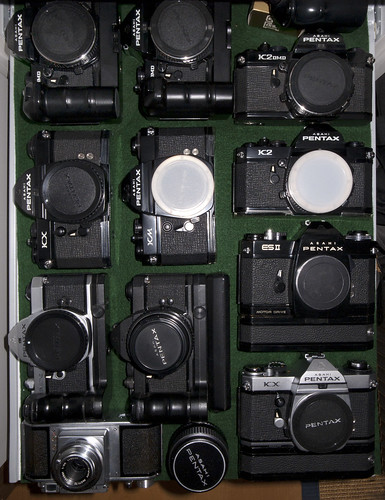
|
| image by wolf4max (Image rights) |
Contents
History
The company that would become Pentax was founded in 1919 as Asahi Kogaku Kogyo G.K. (旭光学工業株式会社) . It was originally an optical company, beginning by making glasses under the Aoco brand (presumably the acronym of Asahi Optical Company), and made its first Aoco projection lens in 1923.[1] It began to produce camera lenses in the early 1930s under the leadership of CEO Kajiwara Kumao and his closest collaborator, Matsumoto Saburo.[2] These lenses were not marked as made by Asahi and were produced for various camera models made by other makers. From 1933 the company produced Optor and meniscus achromat lenses designed at Rokuoh-sha for Konishiroku models. From the mid-1930s to the end of World War II the company was also the main supplier of Molta, then Chiyoda Kogaku Seiko (predecessors of Minolta), whose cameras were equipped with Coronar and Promar lenses.[3][4]
The company changed status in 1938, becoming Asahi Kogaku Kogyo K.K. or Asahi Optical Co. based in Tokyo.[5]
After the war, Asahi made binoculars and polished lenses for several other companies. The first camera produced by Asahi, made as a prototype in 1951 and released in 1952, was the Asahiflex, which was also the first Japanese 35mm SLR. One of the models of the Asahiflex series, the Asahiflex IIb, was the first 35mm SLR to have an instant-return mirror, thus solving the problem of mirror blackout that had plagued SLRs up to that time (early SLRs left the mirror in its "up" position until the camera was wound for the next shot, blacking out the viewfinder).
A series of lenses bearing the name Takumar in honor of Kajiwara Takuma, brother of the founder, were developed for the Asahiflex, which used the 37mm screw mount (1952). The name Takumar was carried over to the 35mm M42x1 mount and 6x7 cameras and went through a series of iterations as build quality and coatings were developed with names such as Super-Takumar, Super-Multi-Coated Takumar, and SMC Takumar until 1975, when the name was changed to SMC-Pentax (even though Takumar lenses were in the catalog until 1979).
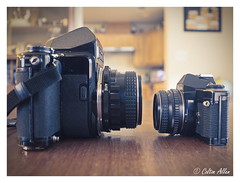
|
| SLRs Pentax 67 and Pentax MX image by Colton Allen (Image rights) |
Pentax was originally the name of another 35mm SLR camera model, introduced in 1957 and successor of the Asahiflex. The name is derived from the shape of the prism used in SLR cameras (pentaprism), and the ending syllable deliberately looks like that of the Zeiss Ikon Contax. In fact, the name Pentax was a property of Zeiss Ikon (West) until they sold it to Asahi Optical Co., maybe strategically, because Zess Ikon's East-German concurrent had relabeled its Contax S SLRs to Pentacon.
Early Pentax cameras were sold in the USA stamped with the name Tower, the house brand of Sears Roebuck & Co., and many others carry the name Heiland, which was the importer and distributor in the USA. Heiland was later acquired by Honeywell until the partnership ended in 1976. These cameras were exactly the same as the ones stamped with the Asahi name.
Pentax was at the time one of the big Japanese camera manufacturers, given their success with 35mmSLR cameras such as the Asahiflex, the Pentax, and the Spotmatic lines. In 1969 Pentax introduced a complete camera systems for rollfilm, the Pentax 6x7. Later it introduced its tiny and popular Pentax Auto 110 for type 110 film cassettes.
In 1957 Asahi Optical Co adopted the M42x1 lens mount for the successful Asahi Pentax (AP) camera, which introduced the auto-diaphragm in the Auto-Takumar lenses for the K-camera and continued using it in the successful S/H line and in the Spotmatic. By 1975 Pentax tried to take the lead with a new lens bayonet, which overcame the limitations of the screw mount and maintained the same flange/film distance as that of the M42 screw mount, thus making it easier for lens makers to offer lenses for both mounts. In fact, the K mount should have been an open bayonet standard, and a handful of other renowned camera makers also used it, among them Pentax's K-mount: Zenit, Topcon, Chinon, Cosina,Ricoh, and Samsung. But most importantly, the mount was further developed and is still in use for Pentax's digital SLRs and even for one of its CSCs, making all new cameras back-compatible.

|
| Auto 110 Pentax' smallest SLR image by Vagn Sloth-Madsen (Image rights) |
The company kept the name Asahi Optical Co. until it became Pentax Corporation in 2002. After successful prototyping since 2000 the company launched its first DSLR with a film twin in 2003, with Pentax K mount. A merger with the Hoya Corporation was completed on October 1, 2007. The new name became Hoya Pentax HD Corporation (HOYA-HD㈱).[6] In summer 2011 Hoya announced that it was selling the imaging branch of Pentax to Ricoh[7] while it will keep the medical branch of Pentax for itself.
In July 2011 Ricoh announced its intentions to purchase the Pentax photographic equipment business from Hoya (which, however, would retain some Pentax-branded medical product lines, etc.)[8]. In August of 2013 the name of the company was changed to Ricoh Imaging. It was announced that the Ricoh branding would be used on compact cameras, while Pentax-branded products would be the DSLRs, interchangeable-lens compact cameras, and binoculars.
Digital
SLR
|
| ||||
|
| ||||
|
|
- Pentax MZ-D (2000) prototype, never released
- Pentax *ist D (2003)
- Pentax *ist DS (2004)
- Pentax *ist DL (2005) also sold by Samsung as GX-1L
- Pentax *ist DS2 (2005) also sold by Samsung as GX-1S
- Pentax *ist DL2 (2006)
- Pentax K100D (2006)
- Pentax K110D (2006)
- Pentax K10D (2006) also sold by Samsung as Samsung GX-10
- Pentax AP 50th Anniv (2007) concept, never released [9]
- Pentax K100D Super (2007)
- Pentax K20D (2008) also sold by Samsung as Samsung GX-20
- Pentax K200D (2008)
- Pentax K-m (2008) also sold as Pentax K2000D in North America
- Pentax K-7 (2009)
- Pentax K-x (2009)
- Pentax K-5 (2010)
- Pentax K-r (2010)
- Pentax K-30 (2012)
- Pentax K-5 II and K-5IIs (2012)
- Pentax K-500 (2013)
- Pentax K-50 (2013)
- Pentax K-S1 (2014)
- Pentax K-S2 (2015)
- Pentax K-3 (2015)
- Pentax K-70 (2016)
- Pentax K-1 (2016) - Full frame
- Pentax K-P (2017)
- Pentax K-3II (2017)
- Pentax K-1 II (2018) - Full frame
- Pentax K-3III (2021)
- Pentax K-F (2022)
- Pentax K3-III Monochrome (2023)
Medium Format SLR
- Pentax 645D (2010)
- Pentax 645Z (2014)
Interchangeable-lens compact
- Pentax Q (2011)
Interchangeable-lens mirrorless
- Pentax K-01 (2012) with K-mount
Point and Shoot Cameras
| - |
1996 2000 2001
2002
2003
2004
|
2005
2006
2007
|
2008
2009
2010
2011
|
35mm film
Asahiflex SLR
Screw-mount Pentax SLR
- Pentax AP (Asahi Pentax camera)
- Pentax K
- Pentax S
- Pentax S1 / H1
- Pentax S1a / H1a
- Pentax S2 / H2
- Pentax S3 / H3
- Pentax SV / H3v
The Spotmatic Series
These cameras were very successful, with a stop-down TTL light metering system that was simple, precise, and at affordable prices. Together with the Takumar lenses, it was one of the best selling cameras of the time. The family of cameras included:
- Spot-Matic prototype (1960)
- Pentax Spotmatic (1964)
- Pentax SL (1968) meterless version of the Spotmatic
- Pentax Spotmatic II (1971) and IIa for the American market
- Pentax Spotmatic F (1973) In combination with S-M-C Takumar lenses, allowed for fully open metering
With the advent of electronics, Asahi developed a camera that used that new technology; the Electro-Spotmatic had "electronic shutter" that was fully automatic and without steps.
- Pentax Electro Spotmatic (1971)
- Pentax ES (1972)
- Pentax ES II (1973)
Asahi also had budget models for entry level enthusiats:
- Pentax SP500 (1971)
- Pentax SP1000 (1974)
K-mount manual focus SLR
Pentax K series
These cameras were launched in 1975, following the success of the Spotmatic, by replacing the M42 mount with K-mount while maintaining the same flange to film distance. Despite being the one with less features of this series, and due to its simplicity and robustness, the K1000 became the eternal student camera.
Pentax M series
Innovation in the form of miniaturization and cameras that were more compact, lighter, and reliable was introduced as the M line in 1976. This generation also brought the line of SMC-Pentax-M lenses. Aperture priority and the use of buttons instead of dials was a characteristic, together with very bright viewfinders with split image. Autofocus was introduced for the first time in a Pentax camera with the ME-F, which used a special lens with built-in focusing motor.
Pentax A series:These cameras introduced electronic communication between the lens and the camera to allow for automatic exposure (Program mode). K-mount lenses with electronic contacts (SMC Pentax-A) were introduced to complement these cameras.
Pentax P series:
Pentax LX
K-mount autofocus SLR
SF series
Z/PZ series
MZ/ZX seriesA series of cameras that were popular in the late 1990s, the single-digit cameras were aimed at advanced amateurs, while the double digits were aimed to amateurs. All had plastic bodies and several program modes. The cameras used the MZ designation in the European and Asian markets and ZX in the Americas.
Compact
645 Medium Format1969-2010 Autofocus 6×7 Medium Format1969-2010
110 film1979-1983 interchangeable lens SLR APS film
LensesAsahi Optical began as a lens fabricator. After World War II they also entered the camera business, and with the introduction of the Asahiflex they also introduced their own line of lenses, giving them the name Takumar. Takumar lenses were used in 35mm and the Pentax 6x7 until 1975, when the badge was replaced with smc-Pentax. Takumar lenses became legendary in the 1960s, with millions produced, and many are still used today on digital cameras.
Asahiflex (37mm) Mount
M42-Mount
K-MountK-mount was introduced in 1975, and is still in use as of 2021. During this time Pentax have produced many different types of lens for the K-mount. They are summarized in the table below. [10]
6x7 Mount
645 Mount
MetersHand held
Asahi lenses on cameras from other makersNot all examples of the cameras listed below have Asahi lenses.
Lenses not labeled as by AsahiFor Konishiroku:
For the predecessors of Minolta:
The Heliostar lenses were perhaps assembled by Asahi (see the discussion there). Lenses labeled as by AsahiNotes
Bibliography
LinksOfficial websites
User groups and community websites
Technical information
In French :
In Spanish :
|






